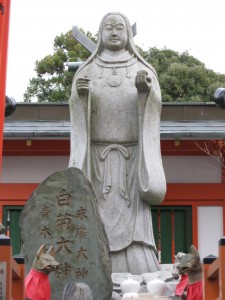I may be wrong, but as far as I know there is no official pantheon of Japanese kami. However, of the eight myriad (yaoyorozu) kami, there are some that are clearly prominent. No doubt it’s possible to … Read the rest
I may be wrong, but as far as I know there is no official pantheon of Japanese kami. However, of the eight myriad (yaoyorozu) kami, there are some that are clearly prominent. No doubt it’s possible to … Read the rest
Shinto is very much an ancestral as well as an animist religion. Many of the leading figures in Japanese history are honoured as part of the national consciousness, and one of the most salient is the statesman, Sugawara no … Read the rest
The spread of Inari belief in the West has taken an important step forward with the launch of an exciting new website dedicated to the deity. It can be found at the following address: http://www.inarishrine.com/
The site is still under … Read the rest
 There are several reasons for thinking that Inari may be the most suitable kami for spreading to the West. Of the three most common kami in Japan – Hachiman, Tenjin and Inari – Inari okami is most clearly animist in … Read the rest
There are several reasons for thinking that Inari may be the most suitable kami for spreading to the West. Of the three most common kami in Japan – Hachiman, Tenjin and Inari – Inari okami is most clearly animist in … Read the rest
Naturalist Kevin Short’s latest piece for the Japan News concerns the irrigation ponds which are often presided over by a Benten shrine, since the deity is associated with water. (For the full article, see here.)
******************************************************
Benzaiten started off … Read the rest
At this time of year we look forward eagerly to the coming of plum blossom as a harbinger of spring. Plum immediately makes one think of Sugawara no Michizane, who is associated with the tree through poetry and legend. … Read the rest
Green Shinto friend, Mark Schumacher, has produced an informative overview of Dosojin for his onmark website about Japanese Religions. Dosojin are protective markers that used to be placed at village boundaries, often with fertility symbols to encourage the growth of … Read the rest
© 2025 Green Shinto
Theme by Anders Norén — Up ↑